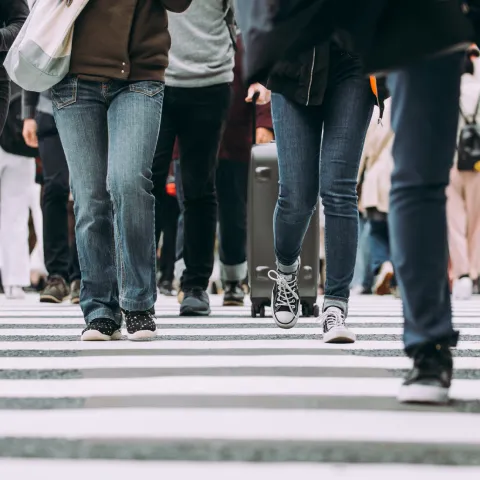Pedestrian Safety in the Community
Pedestrians are vulnerable road users with a high risk of catastrophic injury or death in motor vehicle accidents. Pedestrian safety is everyone’s responsibility. Drivers have a duty to follow traffic laws and use reasonable care to avoid hitting pedestrians.
City planners and governing authorities are responsible for providing and maintaining safe infrastructure that promotes pedestrian safety. Above all, pedestrians must follow traffic laws and take measures necessary to protect themselves, regardless of whether other roadway users do their part.
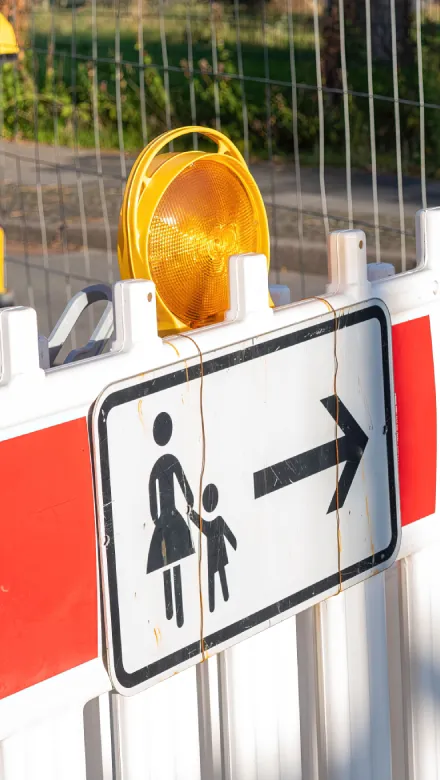
Pedestrian Rights
Most states have adopted all or part of the Uniform Vehicle Code, a set of regulations written by the National Committee on Uniform Traffic Laws and Ordinances. These regulations govern the rights and responsibilities of all roadway users, including pedestrians.
In most states, pedestrians have the right-of-way in intersections marked with a crosswalk if there is no signal. Without a crosswalk, pedestrians must yield the right-of-way to drivers. However, drivers have a duty to watch for pedestrians regardless of whether a pedestrian has the right-of-way. Additionally, pedestrians should always ensure drivers see them before crossing the street.
Pedestrian Laws Vary by State
Not all states apply pedestrian laws in the same manner. For example, some states:
- Require motorists to yield to pedestrians on any part of the road.
- Only require drivers to yield if the pedestrian is in the same half of the roadway as the motor vehicle.
Many states have very specific and unique laws protecting pedestrians. For example, New Jersey requires drivers to move over to the next lane on multi-lane roads or allow at least a four-foot buffer when passing pedestrians on single-lane roads. If neither is possible, they must slow down to 25 mph and be prepared to stop if necessary to avoid injuring pedestrians.
Hazards and Risk Factors for Pedestrians
Traveling can be hazardous for any roadway user, but pedestrians face unique dangers. They lack the protection of being in an enclosed vehicle, while motor vehicle occupants benefit from a crumple zone and additional protection features such as seatbelts and airbags. By contrast, pedestrians are directly impacted when struck by a vehicle.
Pedestrians are safest when they are easy for motorists to see and have sufficient distance from motor vehicles. When crossing a street, the safest crossing areas are areas with clearly marked crosswalks and pedestrian signals. However, these basic amenities are often lacking, even in large cities, and pedestrians pay the highest price.
Low Visibility
Even the most careful pedestrians are endangered when drivers cannot see them. According to the most recent report by the Governors Highway Safety Association, 77 percent of all pedestrian fatalities nationwide in 2021 occurred at night.
City governments can increase pedestrian safety by improving and maintaining street lighting. Low visibility may also occur due to obstructed views caused by things like:
- Tall buildings
- Overgrown trees and shrubs
- Hills and road elevations
- Winding curves
- Weather conditions (e.g., fog)
Dangerous Drivers
Reckless and inattentive drivers are especially dangerous to pedestrians because they are less likely to spot them in time to avoid a crash. In particular, speeding is a significant cause of pedestrian accidents, accounting for 8.1 percent of pedestrian deaths in 2021.
Despite many states restricting cell phone use while driving, distracted driving accidents are also on the rise, with more than 3,500 people killed by distracted drivers in 2021, a 12 percent increase from the year before.
Drunk drivers are more likely to engage in other reckless driving behaviors, such as speeding, and their reaction time is slower. Distracted and drunk drivers may strike pedestrians in crosswalks, walking along the side of a road, and sometimes even on sidewalks.
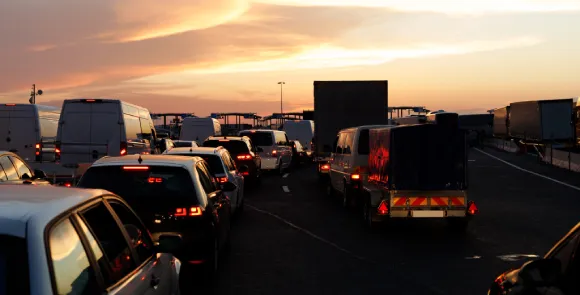
Traffic Congestion
Heavy traffic requires drivers to keep track of more road users, making it more likely that drivers will overlook pedestrians. Vehicles on roadways are diverse, including cars, box trucks, taxis, semi-trucks, buses, SUVs, and more. Drivers of smaller vehicles cannot see around larger vehicles, making it easier to miss a pedestrian crossing the roadway. Large vehicles also block pedestrian views, making it difficult to navigate safely.
High-Speed Roads
The Governor’s Highway Safety Association notes that the most dangerous roads for pedestrians are arterial roads. An arterial road is a major road connecting major centers of activity in a city to freeways and expressways.
These roads usually carry large volumes of traffic at high speeds. Though built for convenience, they also increase risks for pedestrians. Approximately 60 percent of pedestrian fatalities in 2021 occurred on arterial roads. Reduced speed limits, speed bumps, and increased traffic controls like stop signs and traffic lights can slow traffic, increase driver focus, and make these roads safer for pedestrians.
Poor Pedestrian Infrastructure
Government agencies play a crucial role in keeping pedestrians safe. Approximately 69 percent of pedestrian fatalities in 2021 occurred in areas without sidewalks. Governing authorities could enhance pedestrian safety by making the following infrastructure improvements:
- Adding more crosswalks
- Installing green spaces between sidewalks and roads
- Ensuring pedestrian signals give enough time to cross the street
- Reducing the width of the roadways pedestrians cross
- Adding pedestrian safety islands to heavily trafficked streets
Age and Pedestrian Accidents
The CDC reports that 21 percent of pedestrian deaths in 2021 involved adults aged 65 and above despite them representing just 17 percent of the population. This demographic is more vulnerable to the traumatic impact of a crash compared to younger people, resulting in a higher risk of death.
Seniors also have a higher risk of being in a pedestrian accident due to a higher rate of conditions like impaired vision, hearing loss, and reduced mobility.
- Reduced mobility can make it difficult to step off of a curb or cross the street quickly.
- Slower reflexes make it more difficult to take evasive action when threatened with an accident.
- Changes in cognitive abilities make it difficult for some older adults to judge when it is safe to cross the street.
Children also face unique risks when walking near streets. Nearly half of all pedestrian accidents involving children occur when they dart into traffic and fail to watch for cars. Children are likelier to misjudge a vehicle’s speed, take risks, and walk while using smartphones. Interestingly, teens face the highest risk among minor pedestrians, largely due to cell phone distraction.
How To Stay Safe as a Pedestrian
As a pedestrian, what steps can you take to ensure your own safety? You cannot count on drivers to make good decisions, so be prepared to keep yourself safe if a driver fails to see you. Here are some safety tips:
- Keep your eyes on your surroundings and not your cell phone.
- Obey traffic signals.
Cross the street only in designated pedestrian areas. - Check traffic in all directions before crossing the street, even at a crosswalk.
- Watch for cars that may turn into your walking lane, even if you have the right of way.
- Never assume that a driver sees you.
- If you have the right of way, do not assume a driver will honor it.
- When crossing the street, make sure the cars show signs of stopping before crossing.
- Try to make eye contact with the driver as you cross a street. Even a stopped driver may not see you.
- Watch for cars backing out of driveways.
- When walking at night, wear light-colored clothing and incorporate reflective elements.
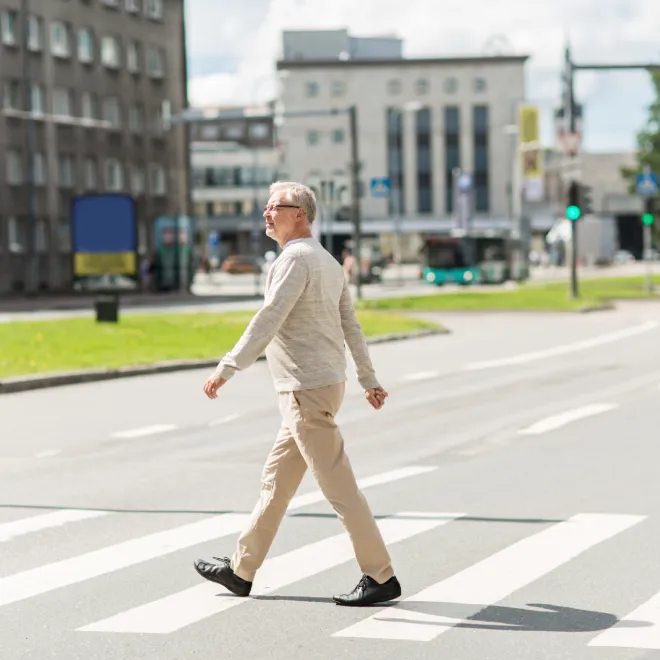
Pedestrian Safety Tips for Seniors
If you are 65 or older, these tips can help you stay safe when crossing the street:
- Avoid routes with wide, complicated intersections.
- Walk with someone if you have impaired mobility, hearing, or eyesight.
- Walk only during daylight hours.
- Cross streets with a group of other pedestrians.
- Wear bright, visible clothing.
- Choose routes with heavy pedestrian traffic and where drivers are used to seeing pedestrians.
Pedestrian Safety Tips for Children
Spend time talking to your children about pedestrian safety before you allow them to walk alone. Walk with your child the first few times on a new route to rehearse safe walking habits and identify potential hazards. Teach your child to follow safety rules, such as:
- Cross the street only at a corner, crosswalk, or intersection.
- Cross only at crosswalks when available.
- Stop and check for cars in all directions before crossing, even at crosswalks.
- Listen for cars as well as look.
- Walk across the street quickly.
- Obey pedestrian traffic signals and the law.
- Walk on sidewalks only.
- Keep your cell phone in your pocket until you reach your destination.
- Remove or turn off headphones when crossing the street.
- Walk with a buddy.
If your child is young, walk with them or designate a trusted adult. Hold hands while crossing the street, and be a model of safe pedestrian behavior.
Signalized Crosswalks
Teach your child how to use signalized crosswalks. Even if no cars are coming, instill the habit of stopping at these crosswalks, pushing the button, and waiting for the walk symbol. Teach your child what each symbol means:
Symbol
Blinking red hand
Meaning
Do not enter the crosswalk. If you are already in the crosswalk, finish crossing.
Symbol
Solid red hand
Meaning
You should not be in the crosswalk. If you are already on the crosswalk, get to the nearest sidewalk as quickly as possible.
Symbol
White or green walking symbol
Meaning
It is safe to enter the crosswalk and cross the street.
Parks and Playgrounds
Closely supervise your child on playgrounds, requiring them to stay in designated play areas. If the child must leave the play area, accompany them. Teach them not to run into the street, even to chase a ball or toy.
Daycares
Daycare centers should ensure outdoor play areas are securely enclosed, and children should only be allowed outside with adult supervision. Children should never be in parking or driving areas except during parent pickup and dropoff times while accompanied by an adult. If your daycare center offers walking field trips, babies should be fastened in strollers. Enough adults should be present to ensure they each are in charge of only a few children at a time.
Getting to School
Walk with your child to school the first few times to identify potential safety hazards and train them to respond appropriately. Choose the safest route available with marked crosswalks. Require your child to use your chosen route every day. Ensure your child leaves early enough to get to school on time without feeling pressured to run or take shortcuts.
Elementary school children should not walk to school near roads without sidewalks. Teach older children and teens to walk on the side of the road facing traffic if no sidewalks are available.
Schools have designated areas where parents can park, pick up, and drop off children, but a recent study found that only 69 percent of parents think the supervision in these zones is adequate. Teach your child to stay alert and find school staff to help them navigate these areas safely.
Safety in Numbers
Walking in groups allows children to look for hazards together and increases their visibility. When walking in groups, children should avoid pushing and shoving.
“Walking school buses” refers to adults who walk children to and from school on a designated route, picking up and dropping off children along the way. Ideally, there should be at least one adult for every six children in a walking school bus. There should be more if many of the children are very young.
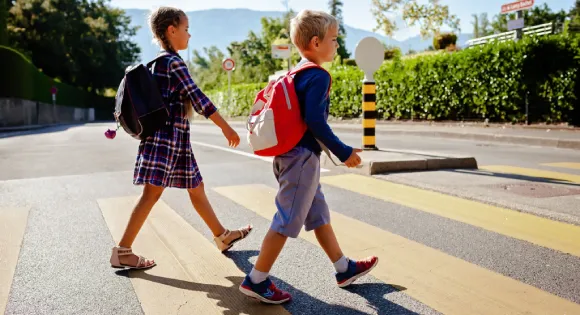
School Bus Stop Safety
Even if your child rides the bus to school, they will walk for at least a short time. If your child is young, walk with them to the bus stop the first few times, teaching them safe walking practices and how to enter and exit the bus safely. School buses have large blind spots, and cars often cannot see around them. Children should follow these safety protocols every time they get on or off a bus:
- Stay in the designated waiting area until the bus comes to a complete stop.
- If crossing the street to get on the bus, the bus lights will turn red, and the stop sign arm will be ejected. Wait until all cars have stopped and the bus driver signals for you to cross.
- When crossing the street after exiting the bus, wait for the driver to signal that it is safe.
- Cross the street several feet in front of the bus, far enough away that the driver is within view. Never cross the street behind the bus.
- Arrive at the bus stop approximately five minutes before the pickup time, and do not run after the bus if it starts to leave.
- If you drop anything after getting off the bus, wait for the bus to leave before attempting to find it.
Other Dangerous Places for Pedestrians
You may not think of yourself as a pedestrian in the locations below, but the same rules apply.
Public Transit Hubs
Safety rules at public transit locations are similar to those around school buses. Stay in designated waiting areas, and avoid running toward the bus or train to catch it. Public transit infrastructure is lacking in many urban areas. Stops may be located too far apart in areas that require riders to walk along busy arterial roads without the assistance of crosswalks. Leave enough time to walk to the transit stop, ensuring you do not have to rush. Avoid crossing the street mid-block to save time.
Parking Lots
Drivers are often more distracted in parking lots than on the roads. Do not assume drivers can see you. Follow the tips below to stay safe in parking lots:
- Watch for drivers pulling out of parking spaces, especially those backing out.
- Do not walk behind vehicles that are backing out.
- Leave plenty of space between yourself and parked vehicles.
- Although drivers are supposed to yield to pedestrians in front of stores, do not assume they will. Wait until they stop before crossing.
- Wait to pull out your cell phone until you reach your car or destination.
Roadsides and Shoulders
If you must walk in an area without a sidewalk, walk facing the traffic so you can be aware of the traffic headed toward you. It is illegal to walk on interstates and expressways in most states. However, if a vehicle breaks down on a major highway, it may be necessary to exit on the roadside or shoulder.
Move-over laws in most states require drivers to slow down or change lanes for emergency vehicles, and these laws often also apply to broken-down vehicles. Still, thousands of people are injured every year near vehicles stopped along roads, often because drivers fail to obey move-over laws. If your vehicle breaks down on a major roadway, watch for speeding cars and stay as far from the traffic as possible. Exit and enter your vehicle through the side farthest from traffic.
Cycling Tips
The National Highways Transportation Safety Administration reports that 1,105 bicyclists were killed in the United States in 2022. Bicycle accidents often occur in areas that lack bike lanes or barriers separating bicycles from cars.
In some areas, bicycle lanes also serve as right-turn lanes, and cars may merge into these lanes without watching for bicyclists. In the absence of bicycle lanes, cyclists must normally ride in the same lane as traffic. However, impatient drivers endanger cyclists by following or passing too closely, while inattentive drivers may fail to see them at all.
When riding a bicycle, wear a properly fitted helmet. The tips below can minimize your chance of being involved in a bicycle accident:

- Wear bright clothing to make it easier to see you.
- Install a light on the front and back of your bicycle when cycling at night.
- Obey traffic signals and stop signs.
- Ride a properly functioning bicycle that is the right size for you.
- Ride with one person per seat and both hands on the handlebars.
- Secure shoelaces and pant legs to avoid them getting caught in the chain.
- When possible, choose routes with low traffic and that are built for bicycles.
- Ride in the same direction as traffic.
- Watch for potholes, grates, and debris in the road.
- Keep your eyes on the road.
- Watch for cars turning or backing out of driveways.
Children ages 10 to 19 have the highest injury rates in bicycle collisions. The most common cause is crossing the street in the mid-block without yielding.
Tips for Drivers to Keep Pedestrians Safe
Every driver has a legal duty to use reasonable care to avoid hurting pedestrians and bicyclists, even if they are in the wrong place. Approximately 7,522 pedestrians were killed in 2022, according to the National Highway Traffic Safety Administration, and 76,000 were injured. Drivers can prevent many of these accidents by following a few important safety rules. For example:
- Watch for pedestrians in crosswalks and prepare to stop.
- Never pass a car that is stopped in front of a crosswalk.
- Scan for pedestrians in low visibility conditions (e.g., foggy weather and at night).
- Drive at or below the speed limit.
- Move over or slow down for disabled and emergency vehicles.
- Obey traffic signals and yield to pedestrians in parking lots and crosswalks.
- Check all of your mirrors and over your shoulder repeatedly when backing.
- Never drive under the influence of drugs or alcohol.
- Avoid activities that take your focus off the road, especially texting and talking on your cell phone.
Pedestrian Safety Is Everyone’s Responsibility
Drivers and pedestrians must work together to promote pedestrian safety. Many pedestrian accidents and deaths could be prevented if drivers obeyed posted speed limits, paid attention to the roads, and didn’t use their cell phones while driving. Pedestrians can also keep themselves safe by using crosswalks, paying attention when crossing the street, and not assuming drivers can always see them.
Many roadways in the United States were designed to make travel as convenient as possible for motor vehicles, but this convenience often comes at the cost of pedestrian safety. Slower speed limits, narrower roads, speed bumps, and crosswalks save lives. Government agencies throughout the country have taken notice, but it will take many years to see meaningful change.
